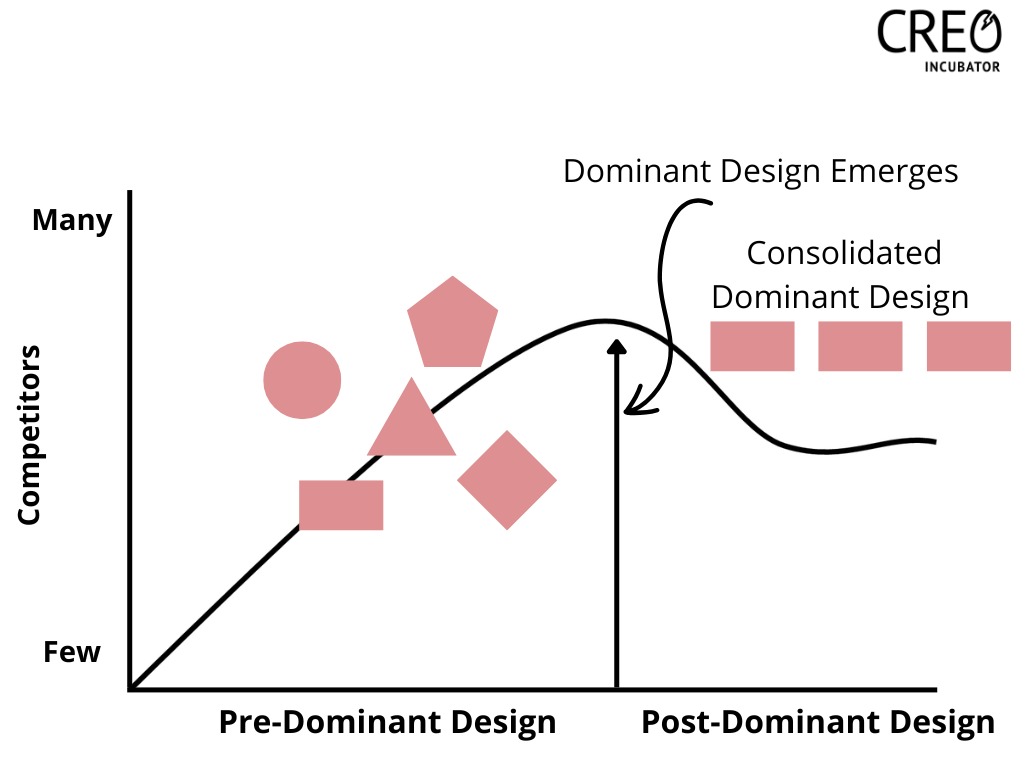The QWERTY keyboard design has been the dominant design for
typewriters and computer keyboards for over a century. Its history dates back
to 1874 when American inventor Christopher Sholes released the Remington
typewriter, which used a keyboard layout similar to the QWERTY design we use
today.
The QWERTY design was not necessarily the most optimal design for typing, but it emerged as the dominant design due to several factors. The pre-dominant design phase saw many companies investing in research and development to develop a design for typewriters. However, the QWERTY design emerged as the dominant design due to market forces and customer preferences. The design was developed to avoid writing jams, which allowed typists to type faster. As a result, customers were more likely to purchase typewriters with the QWERTY design, and it became the standard de facto design that all typewriter manufacturers adhered to.
The emergence of the QWERTY design marked the typewriter's transition into its growth phase, where it gained widespread market success. The dominant design was stable, and customers were more likely to purchase typewriters with the QWERTY design, which further solidified its dominance in the market. The dominant design provided stability to the market, allowing customers to purchase typewriters without worrying about design changes. The QWERTY design's success led to the development of modern-day standard manufactured English letter keyboards, which still use the QWERTY design.
The QWERTY design was not necessarily the most optimal design for typing, but it emerged as the dominant design due to several factors. The pre-dominant design phase saw many companies investing in research and development to develop a design for typewriters. However, the QWERTY design emerged as the dominant design due to market forces and customer preferences. The design was developed to avoid writing jams, which allowed typists to type faster. As a result, customers were more likely to purchase typewriters with the QWERTY design, and it became the standard de facto design that all typewriter manufacturers adhered to.
The emergence of the QWERTY design marked the typewriter's transition into its growth phase, where it gained widespread market success. The dominant design was stable, and customers were more likely to purchase typewriters with the QWERTY design, which further solidified its dominance in the market. The dominant design provided stability to the market, allowing customers to purchase typewriters without worrying about design changes. The QWERTY design's success led to the development of modern-day standard manufactured English letter keyboards, which still use the QWERTY design.

Before a dominant design emerges, companies have the opportunity to innovate and develop a design for novel products. In this pre-dominant design phase, companies face the decision of whether to be a first mover or a late mover.
There are pros and cons to each strategy, as discussed below.
Pros of Being a First Mover:
1. Market Leadership:
First movers have the opportunity to establish themselves as market leaders and gain a significant market share. They have the advantage of being the first to offer a new product or service, which can lead to greater brand recognition and customer loyalty.
2. Early Adopter Advantage:
First movers can take advantage of early adopters who are willing to pay a premium for the latest and greatest technology. This can result in higher profit margins and revenue for the company.
Cons of Being a First Mover:
1. High Costs:
First movers often face higher costs associated with research and development, manufacturing, and marketing. They also face the risk of investing in a design that may not be adopted by the market.
2. Uncertainty:
There is uncertainty associated with being a first mover. Companies are investing in a design that may not be successful, and there is a risk of failure. After a dominant design emerges, companies must decide whether to be a late mover or continue to invest in their pre-dominant design. There are pros and cons to each strategy, as discussed below.
Pros of Being a Late Mover:
1. Lower Costs:
Late movers can take advantage of the dominant design and benefit from the economies of scale associated with mass production. This can result in lower costs and higher profit margins.
2. Market Research:
Late movers have the advantage of observing the market and learning from the mistakes and successes of the first movers. This can result in more informed decision-making and a higher likelihood of success.
Cons of Being a Late Mover:
1. Competitive Disadvantage:
Late movers may face a competitive disadvantage, as they are entering a market that is already dominated by a few key players. This can make it difficult to gain market share and establish themselves as a leader in the industry.
2. Missed Opportunities:
Late movers may miss out on the early adopter advantage and the opportunity to establish themselves as market leaders.
In conclusion, being a first mover or a late mover before and after a dominant design has its pros and cons. First movers have the advantage of establishing themselves as market leaders and taking advantage of early adopters, but they face higher costs and uncertainty. Late movers have the advantage of lower costs and market research, but they may face a competitive disadvantage and miss out on early adopters.
Ultimately, companies must weigh the pros and cons and make informed decisions based on their specific circumstances and goals. For entrepreneurs looking to navigate the complex world of innovation and dominant designs, the Creo Strategy and Innovation course is starting point. The course provides valuable insights and frameworks for choosing the timing of entry and developing an innovation strategy.
There are pros and cons to each strategy, as discussed below.
Pros of Being a First Mover:
1. Market Leadership:
First movers have the opportunity to establish themselves as market leaders and gain a significant market share. They have the advantage of being the first to offer a new product or service, which can lead to greater brand recognition and customer loyalty.
2. Early Adopter Advantage:
First movers can take advantage of early adopters who are willing to pay a premium for the latest and greatest technology. This can result in higher profit margins and revenue for the company.
Cons of Being a First Mover:
1. High Costs:
First movers often face higher costs associated with research and development, manufacturing, and marketing. They also face the risk of investing in a design that may not be adopted by the market.
2. Uncertainty:
There is uncertainty associated with being a first mover. Companies are investing in a design that may not be successful, and there is a risk of failure. After a dominant design emerges, companies must decide whether to be a late mover or continue to invest in their pre-dominant design. There are pros and cons to each strategy, as discussed below.
Pros of Being a Late Mover:
1. Lower Costs:
Late movers can take advantage of the dominant design and benefit from the economies of scale associated with mass production. This can result in lower costs and higher profit margins.
2. Market Research:
Late movers have the advantage of observing the market and learning from the mistakes and successes of the first movers. This can result in more informed decision-making and a higher likelihood of success.
Cons of Being a Late Mover:
1. Competitive Disadvantage:
Late movers may face a competitive disadvantage, as they are entering a market that is already dominated by a few key players. This can make it difficult to gain market share and establish themselves as a leader in the industry.
2. Missed Opportunities:
Late movers may miss out on the early adopter advantage and the opportunity to establish themselves as market leaders.
In conclusion, being a first mover or a late mover before and after a dominant design has its pros and cons. First movers have the advantage of establishing themselves as market leaders and taking advantage of early adopters, but they face higher costs and uncertainty. Late movers have the advantage of lower costs and market research, but they may face a competitive disadvantage and miss out on early adopters.
Ultimately, companies must weigh the pros and cons and make informed decisions based on their specific circumstances and goals. For entrepreneurs looking to navigate the complex world of innovation and dominant designs, the Creo Strategy and Innovation course is starting point. The course provides valuable insights and frameworks for choosing the timing of entry and developing an innovation strategy.
Write your awesome label here.
Never miss our news!
Thank you!
Get updates on live streams, news and more right in your mailbox.



